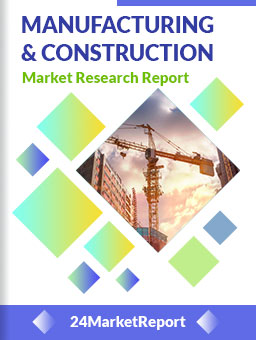The principle of the mass flow controller is to detect and control the gas mass flow by forming the temperature difference between the upstream and downstream of the baseline in the case of overcurrent. The mass flow controller can precisely control the gas mass flow. Its function is to precisely control the flow rate of the carrier gas and reaction gas entering the cavity per unit time to achieve the required mixing ratio for the reaction.
Mass Flow Controller Market aims to provide a comprehensive presentation of the global market for Mass Flow Controller, with both quantitative and qualitative analysis, to help readers develop business/growth strategies, assess the market competitive situation, analyze their position in the current marketplace, and make informed business decisions regarding Mass Flow Controller. Mass Flow Controller Market contains market size and forecasts of Mass Flow Controller in global, including the following market information:
- Global Mass Flow Controller Market Revenue, 2018-2023, 2024-2029, ($ millions)
- Global Mass Flow Controller Market Sales, 2018-2023, 2024-2029, (K Units)
Global top five Mass Flow Controller companies in 2022 (%)
The global Mass Flow Controller market was valued at US$ 540.4 million in 2022 and is projected to reach US$ 814.1 million by 2029, at a CAGR of 6.0% during the forecast period. The influence of COVID-19 and the Russia-Ukraine War were considered while estimating market sizes.
The main manufacturers of mass flow controllers in the market include HORIBA, Bronkhorst, MKS Instruments, etc. The top 5 companies in the world account for nearly 35% of the market. China is the largest market, with a share about 26%, followed by North America and Europe with the share about 22% and 20%.
We surveyed the Mass Flow Controller manufacturers, suppliers, distributors and industry experts on this industry, involving the sales, revenue, demand, price change, product type, recent development and plan, industry trends, drivers, challenges, obstacles, and potential risks.
Total Market by Segment:
Global Mass Flow Controller Market, by Type, 2018-2023, 2024-2029 ($ Millions) & (K Units)
Global Mass Flow Controller Market Segment Percentages, by Type, 2022 (%)
Global Mass Flow Controller Market, by Application, 2018-2023, 2024-2029 ($ Millions) & (K Units)
Global Mass Flow Controller Market Segment Percentages, by Application, 2022 (%)
- Semiconductor Manufacturing
- FPD Industry
- Vacuum Coating
- General Industry
- Photovoltaic Industry
- Fuel Cell
- Analytical Instrument
- Scientific Research
- Others
Global Mass Flow Controller Market, By Region and Country, 2018-2023, 2024-2029 ($ Millions) & (K Units)
Global Mass Flow Controller Market Segment Percentages, By Region and Country, 2022 (%)
- North America
- US
- Canada
- Mexico
- Europe
- Germany
- France
- U.K.
- Italy
- Russia
- Nordic Countries
- Benelux
- Rest of Europe
- Asia
- China
- Japan
- South Korea
- Southeast Asia
- India
- Rest of Asia
- South America
- Brazil
- Argentina
- Rest of South America
- Middle East & Africa
- Turkey
- Israel
- Saudi Arabia
- UAE
- Rest of Middle East & Africa
Competitor Analysis
The report also provides analysis of leading market participants including:
- Key companies Mass Flow Controller revenues in global market, 2018-2023 (Estimated), ($ millions)
- Key companies Mass Flow Controller revenues share in global market, 2022 (%)
- Key companies Mass Flow Controller sales in global market, 2018-2023 (Estimated), (K Units)
- Key companies Mass Flow Controller sales share in global market, 2022 (%)
key players include:
- HORIBA
- Bronkhorst
- Sevenstar
- MKS Instruments
- Brooks
- B?rkert
- TOKYO KEISO CO.,LTD
- Sensirion
- AZBIL
- Sierra Instruments
- Teledyne
- Omega
- Hitachi Metals, Ltd
- Parker Hannifin
- Kofloc
- ACCU
- Fujikin
- Pivotal Systems
- MKP
- Alicat
- Lintec
- AXETRIS
- V?gtlin Instruments GmbH
- ACE
- Outline of Major Chapters:
- Chapter 1: Introduces the definition of Mass Flow Controller, market overview.
- Chapter 2: Global Mass Flow Controller market size in revenue and volume.
- Chapter 3: Detailed analysis of Mass Flow Controller manufacturers competitive landscape, price, sales and revenue market share, latest development plan, merger, and acquisition information, etc.
- Chapter 4: Provides the analysis of various market segments by type, covering the market size and development potential of each market segment, to help readers find the blue ocean market in different market segments.
- Chapter 5: Provides the analysis of various market segments by application, covering the market size and development potential of each market segment, to help readers find the blue ocean market in different downstream markets.
- Chapter 6: Sales of Mass Flow Controller in regional level and country level. It provides a quantitative analysis of the market size and development potential of each region and its main countries and introduces the market development, future development prospects, market space of each country in the world.
- Chapter 7: Provides profiles of key players, introducing the basic situation of the main companies in the market in detail, including product sales, revenue, price, gross margin, product introduction, recent development, etc.
- Chapter 8: Global Mass Flow Controller capacity by region & country.
- Chapter 9: Introduces the market dynamics, latest developments of the market, the driving factors and restrictive factors of the market, the challenges and risks faced by manufacturers in the industry, and the analysis of relevant policies in the industry.
- Chapter 10: Analysis of industrial chain, including the upstream and downstream of the industry.
- Chapter 11: The main points and conclusions of the report.




 Industry Market Size
Industry Market Size SWOT Analysis
SWOT Analysis Industry Major Players
Industry Major Players Revenue Forecasts
Revenue Forecasts Historical and Forecast Growth
Historical and Forecast Growth Profitability Analysis
Profitability Analysis
























